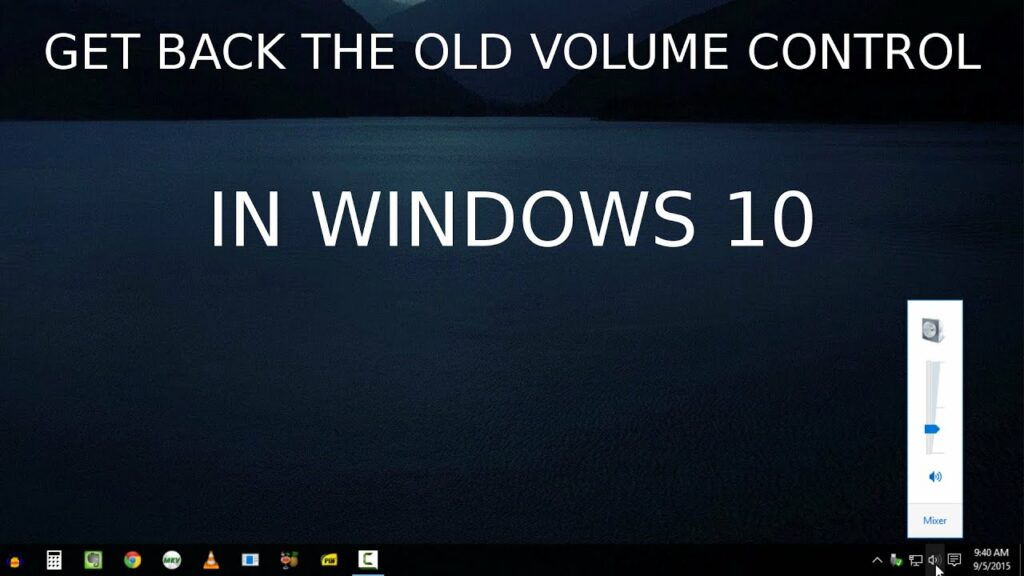Nostalgia Meets Functionality: A Comprehensive Guide on How to Get the Old Volume Control Back in Windows 10

Introduction:
Windows 10, Microsoft’s modern and feature-rich operating system, has undergone numerous updates and improvements over the years. While many users appreciate the advancements, some may find themselves yearning for the simplicity and familiarity of the old volume control. The traditional volume control, characterized by its compact slider and straightforward design, holds a special place in the hearts of long-time Windows users. In this extensive guide, we will explore the methods, tools, and steps to bring back the old volume control in Windows 10, marrying nostalgia with functionality.
Understanding the Shift in Volume Control:
With the advent of Windows 10, Microsoft introduced the sleek and modern Settings app, which encompassed various system configurations, including audio settings. The traditional volume control, accessed through the taskbar, was replaced by a more feature-rich, tile-based system in the Settings app. While the new design offers additional functionalities, some users may prefer the simplicity and efficiency of the classic volume control.
Benefits of the Old Volume Control:
- Simplicity and Familiarity: The old volume control is renowned for its simplicity and straightforward design, making it easy for users to adjust audio levels with a quick glance.
- Compact and Space-Efficient: The traditional volume control is compact, taking up minimal space on the taskbar, which can be particularly advantageous for users who value a clutter-free workspace.
- Quick Access to Playback Devices: The classic volume control provides direct access to playback devices, allowing users to switch between speakers, headphones, or other audio output options with minimal effort.
- Efficient Volume Adjustment: The slider-based design of the old volume control allows for precise and efficient adjustment of audio levels, offering a level of control that some users find preferable.
Methods to Get the Old Volume Control Back:
Several methods and tools can be employed to restore the old volume control in Windows 10, each offering its unique approach. Below are three popular methods that users can explore:
Method 1: Registry Editor
This method involves tweaking the Windows Registry to restore the classic volume control. It’s essential to approach registry edits with caution, ensuring that the steps are followed accurately.
- Open Registry Editor: Press “Windows key + R” to open the Run dialog, type “regedit,” and hit Enter to open the Registry Editor.
- Navigate to the Volume Control Key: In the Registry Editor, navigate to the following key:Copy code
HKEY_LOCAL_MACHINE\SOFTWARE\Microsoft\Windows NT\CurrentVersion\MTCUVC - Modify the Registry Value: Look for the “EnableMtcUvc” DWORD value. If it doesn’t exist, create it by right-clicking in the right pane, selecting “New -> DWORD (32-bit) Value,” and naming it “EnableMtcUvc.” Double-click on it and set its value to 0.
- Restart Explorer: Restart the Windows Explorer process to apply the changes. You can do this by opening the Task Manager (Ctrl + Shift + Esc), locating “Windows Explorer” in the process list, right-clicking it, and selecting “Restart.”
Upon completing these steps, the old volume control should be restored.
Method 2: Third-Party Tools (EarTrumpet)
EarTrumpet is a popular third-party application that brings back the classic volume control while offering additional features and customizations.
- Download and Install EarTrumpet: Visit the official EarTrumpet website or download it from the Microsoft Store. Follow the installation instructions.
- Configure EarTrumpet: Once installed, open EarTrumpet from the system tray. Configure the settings to your liking, and you’ll have a familiar volume control icon on the taskbar.
EarTrumpet not only restores the classic volume control but also enhances it with a modern touch, providing a balance between nostalgia and functionality.
Method 3: Group Policy Editor
This method utilizes the Group Policy Editor to disable the new volume control interface and restore the classic design.
- Open Group Policy Editor: Press “Windows key + R” to open the Run dialog, type “gpedit.msc,” and hit Enter to open the Group Policy Editor.
- Navigate to the Volume Control Policies: In the Group Policy Editor, navigate to:rustCopy code
Computer Configuration -> Administrative Templates -> Control Panel -> Multimedia Settings - Disable the New Volume Control: Look for the policy named “Do not use the search-based method when resolving shell shortcuts” and set it to “Enabled.”
- Restart Explorer: Restart the Windows Explorer process to apply the changes.
This method disables the new volume control search-based method, effectively reverting to the classic design.
Considerations and Additional Tips:
- Backup Registry: Before making any changes using the Registry Editor, it’s advisable to create a backup. This ensures that you can revert to the previous state if any issues arise.
- System Updates: Keep in mind that system updates or major Windows 10 version upgrades may impact the effectiveness of certain methods. After updates, it’s recommended to check the volume control settings and apply the chosen method again if necessary.
- Explore Additional Settings: Some third-party tools, like EarTrumpet, offer additional settings and customization options. Explore these settings to tailor the volume control experience to your preferences.
- Community Forums: If you encounter challenges or have specific questions about restoring the old volume control, community forums and discussions can be valuable resources. Fellow users may provide insights and solutions based on their experiences.
Conclusion:
Restoring the old volume control in Windows 10 is a journey that blends nostalgia with the desire for a familiar and efficient user interface. Whether you choose to delve into the Registry Editor, leverage third-party tools like EarTrumpet, or utilize the Group Policy Editor, the methods provided in this comprehensive guide cater to different user preferences and technical comfort levels. By following the step-by-step procedures and considering the additional tips, users can bring back the classic volume control, creating a more personalized and reminiscent audio experience in the modern Windows 10 environment. Embrace the fusion of past and present, and rediscover the simplicity of the old volume control in your Windows 10 journey.




